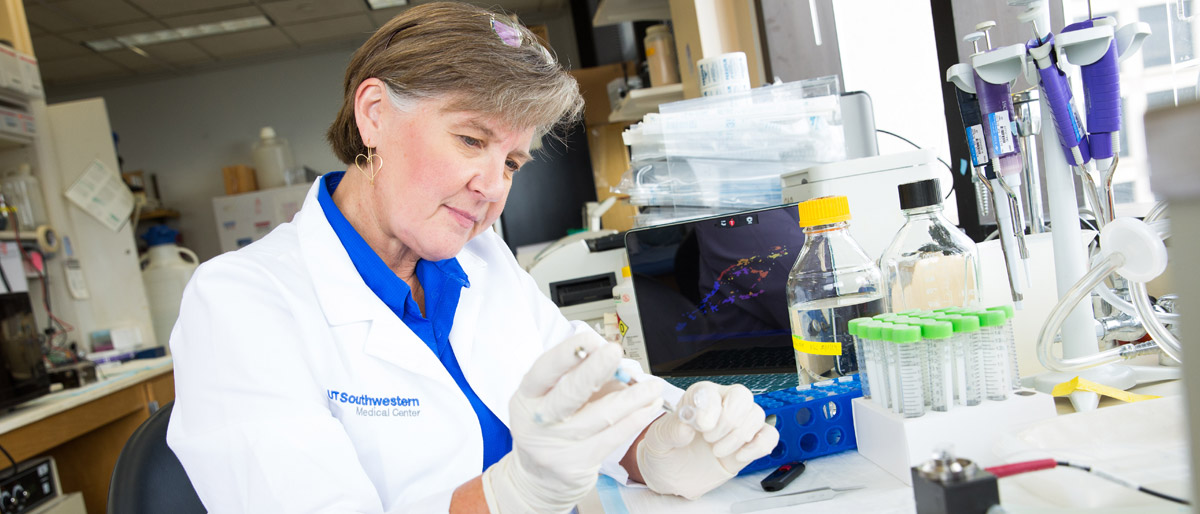$2 million NIH grant funds Down syndrome research

UT Southwestern has been selected to participate in a major National Institutes of Health (NIH) push to discover new treatments and expand clinical research on Down syndrome.
Dr. Beverly Rothermel, Associate Professor of Internal Medicine and Molecular Biology, will lead UTSW’s effort as Principal Investigator of a five-year research project funded by a $2 million grant. Nationwide, 25 institutions received grants totaling $35 million under the NIH program, called Investigation of Co-occurring Conditions Across the Lifespan to Understand Down Syndrome (INCLUDE).
One of Dr. Rothermel’s co-investigators is Dr. Eric Olson, Chairman of Molecular Biology and Director of the Hamon Center for Regenerative Science and Medicine, who is known for his work using gene editing as a potential cure for Duchenne muscular dystrophy. Under the INCLUDE grant, the UTSW research team will investigate the cause of cell-level differences that are seen in Down syndrome patients in the tiny organelles called mitochondria. Specifically, Dr. Rothermel will investigate what effect manipulating the RCAN1 gene has on these mitochondria.
“This grant will allow me to do exactly what I’ve wanted to do for almost 20 years, which is to look at the effect of this gene that is found on the chromosome linked to Down syndrome,” Dr. Rothermel said.
Down syndrome results when a baby receives all or part of a third copy of chromosome 21, instead of just one chromosome from each parent. Having an extra chromosome also means having extra copies of the genes on it, including the RCAN1 gene.
Based on Dr. Rothermel’s research, having an extra RCAN1 gene revs up mitochondrial activity in a way that both increases the potential for oxidative damage and at the same time reduces the ability of cells to repair damaged mitochondria. Over time, this may contribute to premature aging, early Alzheimer’s disease, and other health problems often seen in Down syndrome.
The grant will allow her to test her theory that mitochondria, the powerhouse organelles inside cells, are hyper-active in Down syndrome, eventually damaging themselves. She also plans to use CRISPR-Cas9 gene-editing techniques to remove the extra copy of RCAN1 to see how the deletion impacts Down syndrome-related symptoms. (A 2018 study by Dr. Rothermel, published in Circulation Research, reported that reducing RCAN1 restored normal mitochondrial function in the stem cells being studied.)
In a third branch of her research, Dr. Rothermel will test whether compounds that inhibit RCAN1 can restore normal mitochondrial function. One target for her research is the common antidepressant fluoxetine (brand name Prozac), already given off-label by some parents to children with Down syndrome. Although fluoxetine is widely known as a selective serotonin reuptake inhibitor (SSRI), it can also have direct effects on mitochondria, according to Dr. Rothermel.
About 1 in 700 babies are affected by Down syndrome, resulting in about 6,000 infants born each year in the U.S. with the condition, according to the Centers for Disease Control and Prevention. It is the most common genetic cause of intellectual disability, based on NIH data.
“Individuals with Down syndrome are both affected by and protected against many of the conditions that afflict the general population,” NIH Director Dr. Francis S. Collins said when announcing the INCLUDE grants. “By improving our understanding of the basic biological mechanisms of Down syndrome, and making clinical trials more accessible and specifically tailored to individuals with Down syndrome, we expect that research from the INCLUDE project will benefit everyone.”
INCLUDE was established in June 2018 with $22.2 million in grants, boosting total NIH research funding for Down syndrome by 60 percent last fiscal year. This year’s round of grants added $35 million.
More spending on Down syndrome research is welcome news to Down syndrome parents and advocates, said Jennifer Ford, executive director of the Down Syndrome Guild of Dallas, a group that works to provide resources and support to affected families.
“I think this is so great; it was one of the least-funded conditions under NIH,” Mrs. Ford said.
The number of people living with Down syndrome has increased in recent years, both because families are having children at later ages – raising the risk of genetic error – and because the congenital heart defects common in the syndrome can now be corrected surgically. In the past 25 years, the lifespan for someone with Down syndrome has doubled, from 30 to 60 years, according to the NIH.
As Down syndrome patients live longer, later-life health issues are manifesting themselves. According to the NIH, about 75 percent of those with Down syndrome eventually experience cognitive decline resembling Alzheimer’s disease, but its onset comes 10 to 20 years earlier than for a typical Alzheimer’s patient.
At the same time, said Dr. Rothermel, those with Down Syndrome usually don’t develop diseases such as atherosclerosis (hardening of the arteries) or solid tumors, suggesting that heightened mitochondrial activity might also have a protective effect – a finding that could benefit research into those two diseases.
“This could have broader implications that might have to do with aging as well,” Dr. Rothermel said. “I’m really excited about the potential for this research.”
Other co-investigators who will work with Dr. Rothermel include Dr. Chun-Li Zhang, Professor of Molecular Biology, and Dr. Luke Szweda, Professor of Internal Medicine.
Dr. Olson holds The Robert A. Welch Distinguished Chair in Science, Pogue Distinguished Chair in Research on Cardiac Birth Defects, and the Annie and Willie Nelson Professorship in Stem Cell Research.
Dr. Zhang is the W.W. Caruth, Jr. Scholar in Biomedical Research.

